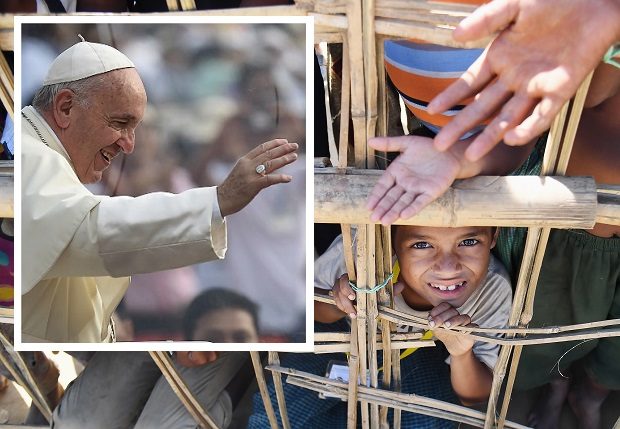
A young Rohingya Muslim refugee looks on through a temporary bamboo barricade at the Thankhali refugee camp in Bangladesh’s Ukhia district on November 10, 2017. Most of the more than 600,000 Rohingya who have fled to Bangladesh since late August don’t know who Pope Francis is. The Pope visited Myanmar and Bangladesh with the plight of the Rohingya high on his mind. AFP
COX’S BAZAR, Bangladesh — The plight of Rohingya refugees is the backdrop to Pope Francis’ landmark visit to Myanmar and Bangladesh this week. But in the vast refugee camps on the border, there is puzzlement, with many asking: “Who is he?”
The head of the Catholic church has repeatedly spoken out in support of the Rohingya, a stateless Muslim minority who have fled to Bangladesh in their hundreds of thousands, bringing with them allegations of murders, rapes and arson committed by the Myanmar military.
This week he met Myanmar’s leader Aung San Suu Kyi and army chief Min Aung Hlaing, who is accused of overseeing brutal campaign to drive out the group that the UN and US have labelled “ethnic cleansing”.
With his message of hope and tolerance, supporters hope the pope’s presence can tamp down the religious and ethnic hatreds that have roiled the region.
Yet in the teeming Bangladeshi camps near the border with Myanmar, mention of the pontiff drew blank faces and raised eyebrows.
Shown a photo, refugees shrugged and guessed him to be anyone from a wealthy king or a celebrity from the US to a Bangladeshi politician. Some mistook his zucchetto for an Islamic skullcap and said he could be a Muslim leader.
“I think I’ve seen him in the news but what does he do? Is he important?” asked 42-year-old Nurul Qadar.
Pope Francis, who arrives in Bangladesh on Thursday from mainly Buddhist Myanmar, is the first pontiff in 31 years to visit Bangladesh and has called the Rohingya his “brothers and sisters”.
He is not due to visit the camps but will meet a small group of Rohingya refugees during an interfaith meeting in Dhaka on Friday.
More than 620,000 Rohingya have poured into the poor, overpopulated country since the start of a violent crackdown by the army in August.
They are denied almost all basic human rights in Myanmar including the right to practise their religion, travel and marry freely.
‘A very wise man’
On learning of the pope’s role in the world, refugees AFP spoke to said they hoped Francis would be able to broker a deal with Myanmar that would pave the way for a safe return to their homeland.
Maybe the government in Myanmar “might actually listen to him,” mused 40-year-old Mujibur Rahman.
Hassan Arraf, a Rohingya imam at Kutupalong refugee camp in Cox’s Bazar in Bangladesh, and the only one out of dozens who knew of the pope, said the Argentinian pontiff with his man-of-the-people reputation had the power to change their lives.
“The way they tortured us, no religion allows it. He is a big leader of another religion but I believe he’s a very wise man,” he told AFP.
“I think he will be able to understand what we went through. And he can ask the Myanmar government to resolve this matter and make the place peaceful.”
Caritas, the Catholic Church’s humanitarian arm which is helping to feed 40,000 families in the camps, said it hoped the pope’s visit would at least help lift the spirits of the community.
“He is coming… as a symbol of reconciliation. We are hoping his visit will bear a very positive impact and create a very good solution between the two countries,” James Gomes, regional director of Caritas, told AFP.
When given information about this unfamiliar robed figure, many refugees said the pope should go to the squalid, overcrowded camps in southern Bangladesh to witness their suffering.
“If his visit is about us, then he should come here to meet us and talk to us. He should see how we are living, how we barely survived,” said Hami Tusang as he queued for food.
Another man behind him, Azim Ullah, said he wanted to “complain to the pope of the relentless torture we face in Rakhine”.
“Being such a big leader, he must be seeing what we have been through. Every bad thing you can think of has happened to us,” he said, making a cutting motion across his throat.
“He needs to be our bridge. He needs to demand our rights, our citizenship. Otherwise there is no point of such visits.” /cbb